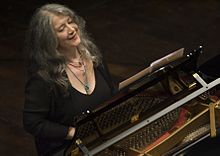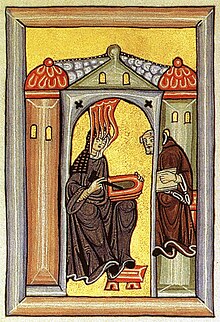Women in classical music: Difference between revisions
subst ill |
Yadsalohcin (talk | contribs) Adjust words to reflect meaning in ==21st century== and found ill for es|Patricia Adkins Chiti |
||
| Line 17: | Line 17: | ||
Following the end of [[World War II]], the number of women in classical music jobs greatly increased in the United States. In 1947, only 8% of symphony orchestra musicians were women, compared to 26.3% in 1982. <ref name=":0" /> The number of women in European orchestras, however, continued to remain low. Women in [[tenured]] composition positions at universities also remained very uncommon in the 1970s, with 10.6% of those positions occupied by women.<ref name=":0" /> |
Following the end of [[World War II]], the number of women in classical music jobs greatly increased in the United States. In 1947, only 8% of symphony orchestra musicians were women, compared to 26.3% in 1982. <ref name=":0" /> The number of women in European orchestras, however, continued to remain low. Women in [[tenured]] composition positions at universities also remained very uncommon in the 1970s, with 10.6% of those positions occupied by women.<ref name=":0" /> |
||
In 1984 [[Odaline de la Martinez]] became the first woman to conduct at a [[BBC Promenade Concerts|BBC Promenade Concert]]<ref>{{cite web |url=http://www.classical-music.com/article/11-of-best-female-conductors |title=11 of today's top women conductors |date=6 March 2015 |first=Rosie |last=Pentreath| accessdate=17 November 2016 }}</ref> at the [[Royal Albert Hall]]. |
|||
== 21st century == |
== 21st century == |
||
The ratio of women to men in U.S. orchestras is roughly equal, but the ratio in European orchestras is still low.<ref name=":1" /> |
The ratio of women to men players in U.S. orchestras is roughly equal, but the ratio in European orchestras is still low.<ref name=":1" /> There are relatively few women conductors, but numbers are increasing, as figures like [[Marin Alsop]], [[Barbara Hannigan]], [[Susanna Mälkki]] and [[Mirga Gražinytė-Tyla]] gain public attention and popularity.<ref name="nytimes1" /> |
||
== Redress == |
== Redress == |
||
Among the groups seeking to redress the gender imbalance in music are: |
Among the groups seeking to redress the gender imbalance in music are: |
||
* The International Alliance for Women in Music<ref>{{cite web |url=http://iawm.org/about-us/ |title=About Us |website=iawm.org |publisher=iCreateforU |accessdate=15 November 2016 |archiveurl=http://web.archive.org/web/20161116172617/http://iawm.org/about-us/ |archivedate=16 November 2016 |deadurl=no}}</ref> |
* The International Alliance for Women in Music<ref>{{cite web |url=http://iawm.org/about-us/ |title=About Us |website=iawm.org |publisher=iCreateforU |accessdate=15 November 2016 |archiveurl=http://web.archive.org/web/20161116172617/http://iawm.org/about-us/ |archivedate=16 November 2016 |deadurl=no}}</ref> |
||
* Fondazione Adkins Chiti: Donne in Musica<ref>{{cite web |url=http://www.donneinmusica.org/www/en/index.php?lang=en |title=Fondazione Adkins Chiti: Donne in Musica |website=donneinmusica.org |accessdate=15 November 2016 |archiveurl=http://web.archive.org/web/20161116172751/http://www.donneinmusica.org/www/en/index.php?lang=en |archivedate=16 November 2016 |deadurl=no}}</ref> headed by Patricia Adkins Chiti, a member organisation of the [[UNESCO]] [[International Music Council]] (see [[European Music Council]]) |
* [[Fondazione Adkins Chiti: Donne in Musica]]<ref>{{cite web |url=http://www.donneinmusica.org/www/en/index.php?lang=en |title=Fondazione Adkins Chiti: Donne in Musica |website=donneinmusica.org |accessdate=15 November 2016 |archiveurl=http://web.archive.org/web/20161116172751/http://www.donneinmusica.org/www/en/index.php?lang=en |archivedate=16 November 2016 |deadurl=no}}</ref> headed by {{ill|es|Patricia Adkins Chiti}}, a member organisation of the [[UNESCO]] [[International Music Council]] (see [[European Music Council]]). |
||
== References == |
== References == |
||
Revision as of 13:44, 17 November 2016

Women have been active in many aspects of classical music, such as instrumental performance, vocal performance, orchestral conducting, choral conducting, scholarly research, and contemporary composition.
Women were nonexistent in most major music symphony orchestras up until the 1960s.[1] This imbalance has been particularly notable in music directorships of symphony orchestras, with 4.1% of major orchestras in the United States led by a woman, as of November 2016,[2] and out of the 150 recognized top conductors in the world, only 3.3% were women.[3] The gap also extends to member positions in symphony orchestras. In 2003, the Vienna Philharmonic appointed its first woman musician in 2003 after 161 years of operating without women,[2] after removing the ban on women musicians in 1996, when it was threatened with budget cuts by the Austrian government.[4] In 1982, the Berlin Philharmonic hired its first woman, Madeleine Carruzzo, after a controversy in which the long-standing music director Herbert von Karajan resigned in protest.[5][6] The first orchestra in the world to ever hire women musicians was the Queen's Hall Orchestra in London in 1913, led by Sir Henry Wood.[7] Before 1913, women played in women-only orchestras, the first of which was founded by Mary Wurm in 1898 in Berlin.[7] The first woman to join an American orchestra was harpist Edna Phillips, who was accepted into the Philadelphia Orchestra in 1930.[7]
Although women have not had roles in symphony orchestras until recently, it has been much more common for women to study musical instruments. In the 1800s, upper-class women often were expected to learn an instrument, often the harp, piano, guitar, or violin, or to learn to sing.[7] Women have also performed in the soloist setting more frequently, with prominent examples being pianist Clara Schumann and vocalist Jenny Lind.[7][8]
History

One of the first historically recorded women in medieval music was Hildegard of Bingen, who wrote religious songs in the 12th century.[9] Women have also been necessary for the functioning of choirs, which require the upper register that women can sing,[10] although Pope Leo IV (847–855 A.D.) banned women in choirs from singing in churches, and Pope Pius X banned women from church choirs in 1907.[11] Antonio Vivaldi led an all-girl orchestra in 1714 at a school for girls.[12]
It used to be considered proper for a young woman in upper society to attain proficiency on a classical instrument, usually the piano, harp, classical guitar, or voice. Women were not trained as professionals, however, because it was considered immodest for a woman to perform in public.[8] These etiquette guidelines were typically spread by books such as Letters to a Young Lady written by John Bennett in 1798, and Letters to Young Ladies written by Lydia Sigourney in 1844.[8] Musical performance was seen as a feminine pursuit, and thus schools for women often had more of a focus on music than schools for boys. In fact, the first music conservatory in the United States, Music Vale Academy, was established in 1835 for the purpose of teaching women music. The culture of women learning music was so strong in the 18th century that Martha Jefferson and George Washington's stepdaughter Eleanor Curtis Parke were musicians.[8]
Women did not compose classical music often in the 18th century. While compositions written by women were acceptable in Europe and Great Britain, compositions written by American women were often vaguely attributed or unattributed.[8]
From 1870 to 1910, women started to take more jobs in classical music, usually teaching positions. American Clara Baur was the first woman to found a conservatory, the University of Cincinnati – College-Conservatory of Music, in 1867.[8] The growing American popularity of opera music in this time period also contributed to a rising number of women in classical music, as women were needed to sing prominent female parts.[8] In 1936, Nadia Boulanger conducted a concert with the London Philharmonic, the first woman to do so. Boulanger also went on to conduct the Philadelphia Orchestra, Boston Symphony, and New York Philharmonic in the following years.[1]
Following the end of World War II, the number of women in classical music jobs greatly increased in the United States. In 1947, only 8% of symphony orchestra musicians were women, compared to 26.3% in 1982. [8] The number of women in European orchestras, however, continued to remain low. Women in tenured composition positions at universities also remained very uncommon in the 1970s, with 10.6% of those positions occupied by women.[8]
In 1984 Odaline de la Martinez became the first woman to conduct at a BBC Promenade Concert[13] at the Royal Albert Hall.
21st century
The ratio of women to men players in U.S. orchestras is roughly equal, but the ratio in European orchestras is still low.[1] There are relatively few women conductors, but numbers are increasing, as figures like Marin Alsop, Barbara Hannigan, Susanna Mälkki and Mirga Gražinytė-Tyla gain public attention and popularity.[2]
Redress
Among the groups seeking to redress the gender imbalance in music are:
- The International Alliance for Women in Music[14]
- Fondazione Adkins Chiti: Donne in Musica[15] headed by es, a member organisation of the UNESCO International Music Council (see European Music Council).
References
- ^ a b c "Not-So-Frequently Asked Questions". Salisbury Symphony Orchestra, Salisbury University. Archived from the original on 6 November 2016. Retrieved 6 November 2016.
{{cite web}}: Unknown parameter|dead-url=ignored (|url-status=suggested) (help) - ^ a b c Michael Cooper (1 September 2016). "Cracking a Glass Ceiling with the Maestro's Baton". The New York Times. Archived from the original on 5 November 2016. Retrieved 5 November 2016.
{{cite web}}: Unknown parameter|deadurl=ignored (|url-status=suggested) (help) - ^ Rowland, Hazel (8 April 2016). "Where Are All The Women Conductors?". The Culture Trip Ltd. Archived from the original on 5 November 2016. Retrieved 5 November 2016.
{{cite web}}:|archive-date=/|archive-url=timestamp mismatch; 6 November 2016 suggested (help); Unknown parameter|dead-url=ignored (|url-status=suggested) (help) - ^ Jane Burgermeister (9 January 2003). "First woman takes a bow at Vienna Philharmonic". Guardian News. Archived from the original on 5 November 2016. Retrieved 5 November 2016.
{{cite web}}:|archive-date=/|archive-url=timestamp mismatch; 6 November 2016 suggested (help); Unknown parameter|deadurl=ignored (|url-status=suggested) (help) - ^ James R. Oestreich (16 November 2007). "Berlin in Lights: The Woman Question". The New York Times. Archived from the original on 19 November 2007. Retrieved 5 November 2016.
{{cite web}}: Unknown parameter|deadurl=ignored (|url-status=suggested) (help) - ^ Newman, Geoffrey. "The Rise of the Female Conductor". Vancouver Classical Music. Archived from the original on 5 November 2016. Retrieved 5 November 2016.
{{cite web}}:|archive-date=/|archive-url=timestamp mismatch; 6 November 2016 suggested (help); Unknown parameter|dead-url=ignored (|url-status=suggested) (help) - ^ a b c d e Cynthia Collins (9 March 2015). "Contribution of Women Musicians to Symphony Orchestras". CMUSE.org. Archived from the original on 5 November 2016. Retrieved 5 November 2016.
{{cite web}}:|archive-date=/|archive-url=timestamp mismatch; 6 November 2016 suggested (help); Unknown parameter|deadurl=ignored (|url-status=suggested) (help) - ^ a b c d e f g h i Tick, Judith; Tsou, Judy. "Women in music". Oxford University Press. Archived from the original on 5 November 2016. Retrieved 5 November 2016.
{{cite web}}:|archive-date=/|archive-url=timestamp mismatch; 6 November 2016 suggested (help); Unknown parameter|dead-url=ignored (|url-status=suggested) (help) - ^ Maddocks, Fiona (2001). Hildegard of Bingen: The Woman of Her Age. New York: Doubleday. p. 194.
- ^ McKinney, James (1994). The Diagnosis and Correction of Vocal Faults. Genovex Music Group. ISBN 978-1-56593-940-0.
- ^ Wijngaards, John. "Women and girls were not allowed to be singers in Church". womenpriests.org. Wigngaards Institute for Catholic Research. Archived from the original on 5 November 2016. Retrieved 5 November 2016.
{{cite web}}:|archive-date=/|archive-url=timestamp mismatch; 6 November 2016 suggested (help); Unknown parameter|dead-url=ignored (|url-status=suggested) (help) - ^ White, Micky (2004). "The Pieta in Vivaldi's Day". Vivaldi's Women. Schola Pietatis Antonio Vivaldi. Archived from the original on 6 November 2016. Retrieved 6 November 2016.
{{cite web}}: Unknown parameter|dead-url=ignored (|url-status=suggested) (help) - ^ Pentreath, Rosie (6 March 2015). "11 of today's top women conductors". Retrieved 17 November 2016.
- ^ "About Us". iawm.org. iCreateforU. Archived from the original on 16 November 2016. Retrieved 15 November 2016.
{{cite web}}: Unknown parameter|deadurl=ignored (|url-status=suggested) (help) - ^ "Fondazione Adkins Chiti: Donne in Musica". donneinmusica.org. Archived from the original on 16 November 2016. Retrieved 15 November 2016.
{{cite web}}: Unknown parameter|deadurl=ignored (|url-status=suggested) (help)
